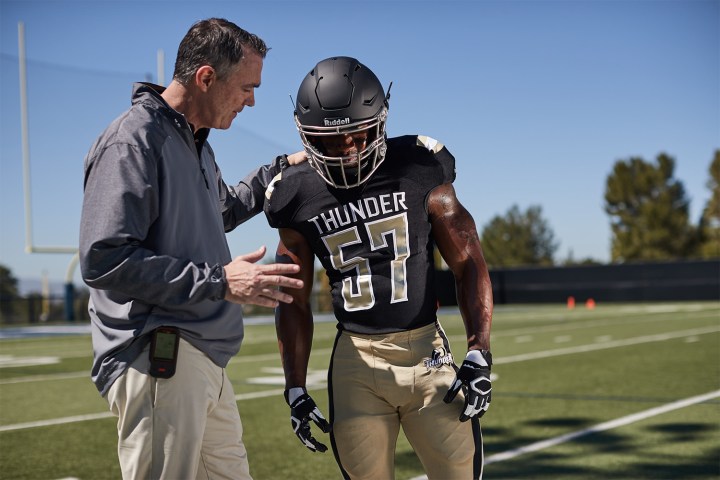
When Chris Messano lined up as a Northern Michigan University Wildcats wide receiver in the early 2000s, he remembers the then-high tech way the school trained its player. The Division II football program had a coach who was responsible for cutting up VHS tape into offense- and defense-specific film and making copies to share.
But less than two decades later, even the rural high school where Messano now coaches has technology that you might find on an NFL team.
Messano, the offensive coordinator for the Marquette Senior High School Redmen football team in Michigan’s Upper Peninsula, just has to click a few boxes online to share any play from any game to any player or coach. No snipping, editing or copying required.
“It’s much easier to break film up and immediately disperse it to all of your players,” Messano, also a former high school head coach, told Digital Trends. “It makes communication much easier, whether that be with other coaches, players, parents, recruits, et cetera. Breaking down and sending film has saved countless hours.”
Online video is one of many technological advances for football programs at the high school level as professional-level technology filters down into the high school and prep-level game. Wireless communication between coaches during games, mobile app-based workouts and the ability to reach every player instantly are now everyday parts of prep-level football.
High tech meets high school
Hudl, the top digital scouting and film breakdown company for high school football, opened its doors in Lincoln, Nebraska, in 2006 with hopes of touting its product to NFL and collegiate programs. It wasn’t long before the company realized where its true growth potential was: High school programs.
“We started going to clinics and talking to coaches,” Nate Patterson, Hudl’s product manager, told Digital Trends. “The speakers there would be offensive coordinators or defensive coordinators from college or NFL teams, and these high schools would come by and want to buy the software.
More than 140,000 teams use Hudl’s big-league technology in practice and games.
“That turned into the other idea of actually building a system and an editor that could scale into the high school space,” he said.
Hudl quickly invested resources into a product designed for prep sports teams. Besides teams adopting Hudl as an app and browser-based software, athletes began using the school’s tools to make their own highlight clips and share them to grab collegiate recruiters’ attention.
In turn, recruiters encouraged the system’s use, which allowed them to scout and evaluate a larger number of players from more geographically diverse schools.
More than 140,000 teams use Hudl’s big-league technology in practice and games, and the complexity of that technology keeps growing. One such product is Hudl Sidelines, which gives coaches on the sideline the ability to review a play immediately, with an iPad or streamed to HD televisions for players to see.

“Sidelines allows for multi-angle live review with no Wi-Fi needed,” Patterson said. Coaches and players can then make real-time adjustments in response, something only dreamed of until recently.
Patterson and his team see that replay ability eventually making the high school game even more like college and professional football through official reviews.
“While [replay reviews are] still only allowed in a few states, we believe this is the direction the game is going and the current version of Sideline is just scratching the surface for what we believe live review will look like in the next few years,” he said.
Building a better helmet
To the casual observer, a technology that seems not to have changed much over the past couple of decades has seen some of the greatest innovation: The football helmet. Those advances, like impact sensors or lightweight materials, are hidden beneath the hard exterior.
Helmet manufacturer Riddell has invested in creating NFL-quality protective gear for every level of play, the company’s communications director, Justin Kenny, told Digital Trends.
The SpeedFlex Diamond was rated the top helmet in the 2020 NFL/NFLPA Helmet Laboratory Testing Results and uses 3D data to create custom-fitted liners for the most impact absorption available. That helmet — which was introduced at the NFL and college levels — is now available for high school players to use.
“We anticipate widespread use this fall by youth and high school players,” Kenny said.

Riddell also builds smart helmet technology, InSite, that allows coaches and trainers to monitor impacts. That data can then modify training techniques and practice plans to help players avoid dangerous impacts to the head as much as possible.
“Through expanded integration of our helmets with InSite, we expect that in the next five years, players at all levels will have smart helmet instrumentation of some kind,” said Kenny, noting they’ve collected data on more than 7 million on-field impacts so far.
Researchers at Virginia Tech have been independently testing helmets for the past nine years and releasing their findings to the public. Many of the current models available for varsity football teams rate at the highest-possible five stars.
“Helmets will never eliminate concussions, but they are effective at reducing risk and which helmet you choose matters,” Steve Rowson, associate professor in Virginia Tech’s department of biomedical engineering and mechanics, told Digital Trends. “Today’s helmets compared to helmets 10 years ago provide a substantial reduction in concussion risk. If we look at the helmets available 10 years ago, differences in concussion risk by model varied by over 50 percent. The top-performing helmets of today perform much better than what was available.”
Sensor technology has helped protect players by eliminating and reducing plays and drills that are more harmful than good. Improvement in the protection for prep football players can only help a sport that has struggled to maintain participation numbers in recent years, much of which is due to concerns over concussions and the long-term effects.
“Pairing sensor systems that measure head impacts with video plays an important role in making the game safer,” Rowson said. “In the past, high-risk scenarios, like kickoffs or the Oklahoma drill, have been identified, and various leagues have taken them out of the game. This is a data-driven approach that can drastically reduce head impact exposure. Understand the head impacts and how they occur first, and then make informed decisions to reduce concussion risk. The less head impact, the better.”
More advancements are on the horizon from companies like these, and one such technology could even take camera operators out of the equation. Hudl is currently field-testing an auto-tracking camera that can record games based on a team’s home schedule, automatically follow all the in-game action (optionally, live streaming it online), and upload the high-definition video for coaches to break down and share.
“We are running a beta this season with a select number of schools with the goal of making the camera more widely available for the 2021 season,” said Patterson.
As access to cutting-edge equipment and technology at the prep level grows, there is little doubt high school teams will continue to take advantage of it. Safety, training, game performance, and collegiate recruiting all stand to benefit, which makes the future at the intersection of high school football and tech something to cheer about.




